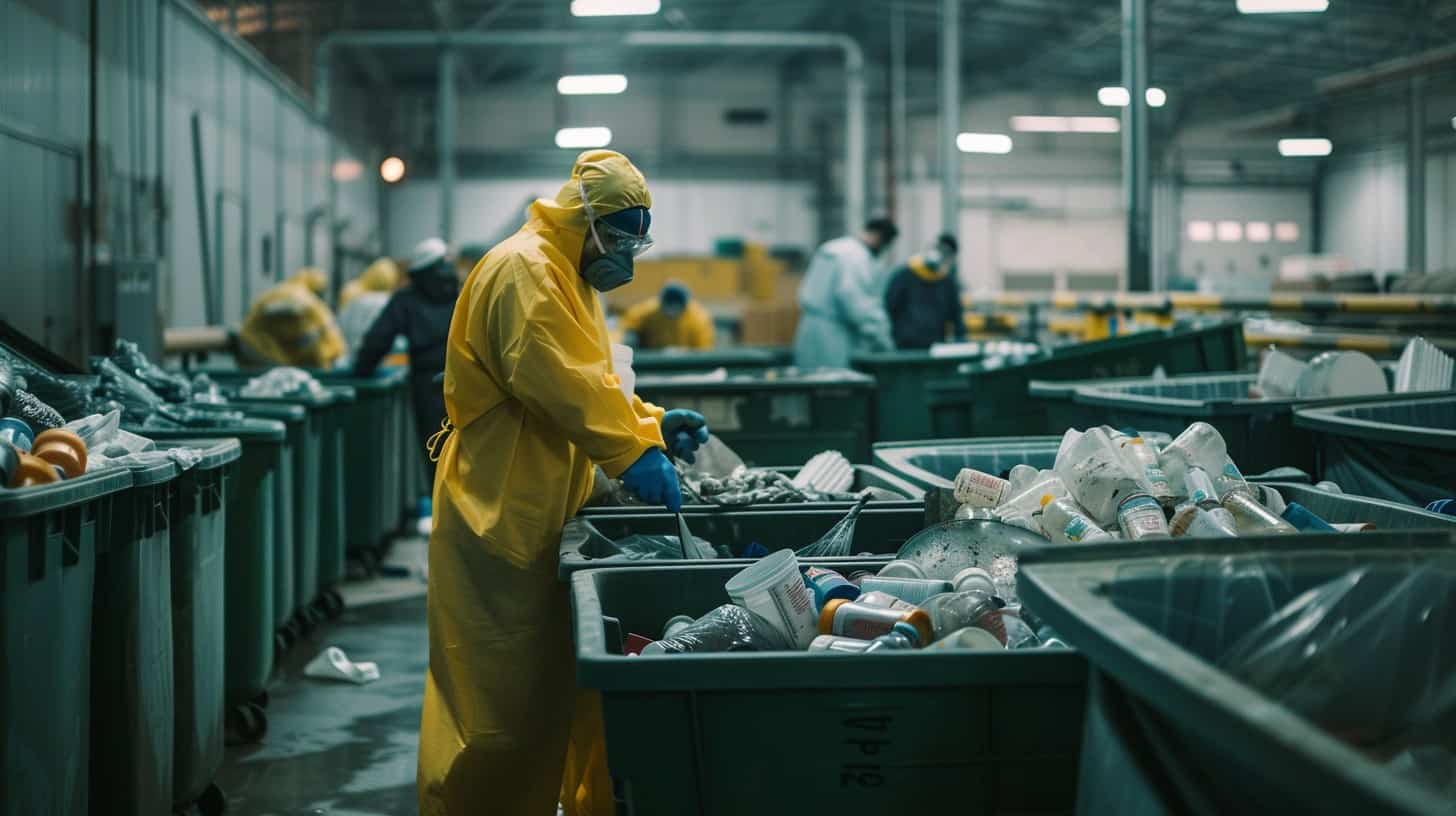Ever found yourself in the doctor’s office, post-exam, glancing at the overflowing trash bin and wondering where it all goes? You’re not alone. Curiosity got the best of me too – so much that I dug into the intricacies of medical waste disposal to see what actually happens to those used needles, gauze pads, and discarded gloves after we wave goodbye to our clinicians.
It turns out there’s an entire law geared towards this – meet the Medical Waste Tracking Act of 1988. It’s like a GPS for healthcare rubbish! But don’t worry; I’ve done the legwork to unveil whether these items end up buried beneath piles of everyday garbage or are transformed through some sci-fi worthy process.
Stick around because we’re about to unravel these mysteries together. And who knows? The journey through medical waste management might just be more intriguing than you ever imagined.
Key Takeaways
Medical waste includes things like used needles, bloody bandages, and old medicines that can’t be thrown in regular trash because they might make people sick or hurt the environment.
Special places called Treatment, Storage and Disposal Facilities (TSDF) deal with medical waste by burning it up or using machines to kill germs. Some hospitals also have their own ways to clean waste before getting rid of it.
It’s important for medical stuff like needles and gloves to go into special bins, so workers know how to handle them safely. There are rules for this, like the Medical Waste Tracking Act of 1988.
Not all medical waste gets thrown out—some can be recycled into new things, which helps our planet.
Everyone who works at a hospital learns about the right way to throw away different kinds of medical waste, so nobody gets sick, and we keep our water and land safe.
Table of Contents
Understanding Medical Waste
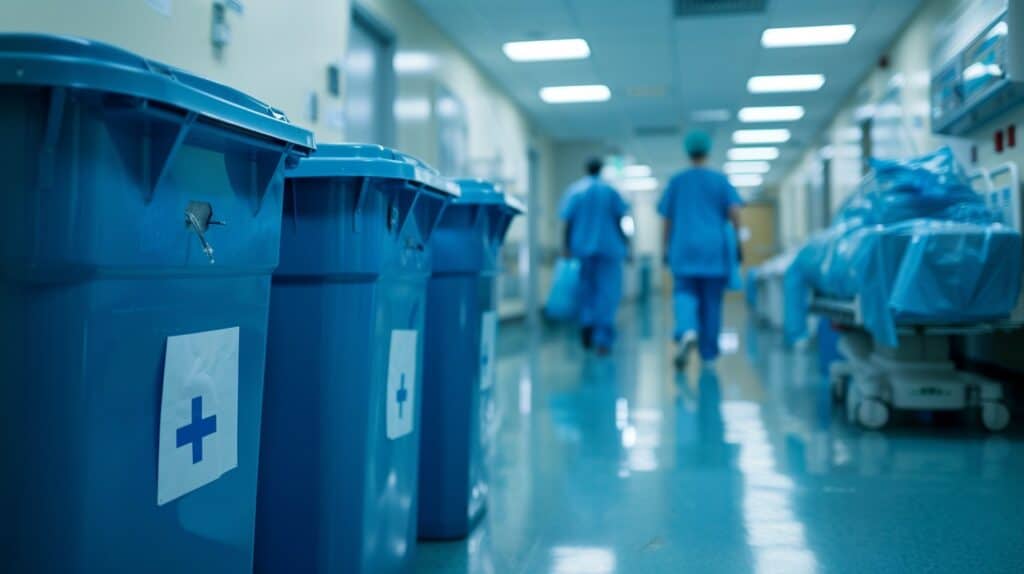
Hey fellas, let’s have a little chat about something we don’t often think about unless it’s staring us in the face – medical waste. “What is it really?” you might wonder. Well, imagine all the stuff that can’t just be tossed into your regular trash can after a visit to the doc or when healthcare pros do their thing… yup, from those weird chemicals to needles and beyond. It’s a whole world of “ick” that needs some serious TLC before it says goodbye for good.
And trust me; this isn’t just gross – getting rid of this stuff the wrong way could wreak havoc on our health and dear Mother Earth! So let’s take a deep dive (not literally, thank goodness!) into what exactly falls under medical waste and why handling it with kid gloves matters big time.
Chemical Waste
I’ve got to talk about something heavy—chemical waste from the medical world. This stuff is not your average trash. We’re dealing with things like old meds, used-up disinfectants, and other risky materials that can really mess up the environment if tossed out the wrong way.
Now, here’s what gets me—there are special rules for getting rid of this kind of waste safely. Think about it: just tossing a half-empty bottle of acetone in the regular bin? Not cool, guys.
It needs careful handling by pros who know their hazardous waste protocols inside out. They make sure everything harmful stays away from our water and land where it could harm us or animals.
So let’s keep doing our part, making sure we don’t cut corners when it comes to ditching chemical gunk properly. It keeps everyone safer—that means you, your family, and even those critters outside going about their day-to-day lives without a clue what dangerous chemicals might be lurking around!
Laboratory Waste
So, let’s talk about stuff from labs that we can’t just toss in the trash. This includes all those used test tubes, old gloves, and chemicals from experiments. Lab waste can be pretty nasty and needs special handling to keep us and the environment safe.
First things first, they don’t end up where our regular garbage goes. Nope. This lab junk has its own VIP treatment—it gets autoclaved or burned up to destroy bad germs and toxic stuff before it says bye-bye for good.
That means professionals take care of it in a way that keeps everyone healthy and follows the rules—like those set by big shots such as the Environmental Protection Agency (EPA) and Occupational Safety and Health Administration (OSHA).
Trust me; you wouldn’t want any of this biohazardous waste hanging around!
Pharmaceutical Waste
I know that tossing out old meds seems easy, but there’s a right way to do it. Pharmaceutical waste includes all those expired pills and liquid medicines we have at home. Before throwing them away, they need special treatment so they don’t harm the environment or people.
You can take your unused drugs to drop-off sites or places specially made for getting rid of medical stuff safely.
Now, not everyone knows this, but ways to treat pharmaceutical waste include cooking them with steam in an autoclave, using living things to break them down biologically, or zapping them with chemicals.
Really cool science stuff! These steps make sure our water stays clean, and our land is safe from harmful leftovers. Trust me—it’s worth doing right for our planet’s health… and ours too!
Chemotherapy Waste
After talking about pills and potions, let’s get into something heavier—chemotherapy waste. This stuff is serious business because it can be dangerous if not handled right. Imagine things like IV bags, tubes, little bottles, and needles that were used for cancer-fighting drugs.
At places like Moffitt Cancer Center, they take great care to collect this kind of waste right where it was used. Then they move it safely off to a room just for dirty stuff until a special medical waste truck comes to pick it up.
Now you might wonder—what makes chemo waste so special? Well, these items have touched powerful drugs designed to kill cancer cells but could also harm healthy people or the environment if tossed out with normal trash.
So here’s what happens: Workers put on gloves and make sure every bit of chemo gear gets into its own secure bin before hauling it away properly. That way we keep folks safe—including us guys—and respect the planet too!
Biomedical Waste
Biomedical waste is the scary stuff you don’t want to mess with. We’re talking bloody bandages, needles, human tissues, and anything soaked in blood. Pretty gross, right? Hospitals and clinics make a lot of this junk when they take care of us.
I get how important it is to toss out biomedical waste the right way. If we don’t do it correctly, nasty germs could spread diseases or hurt our planet. So there’s this tight ship we’ve got to run – sterilizing everything with heat or burning it until there’s nothing bad left that can harm anyone or anything.
Medical Waste Disposal: Where Does It Go?
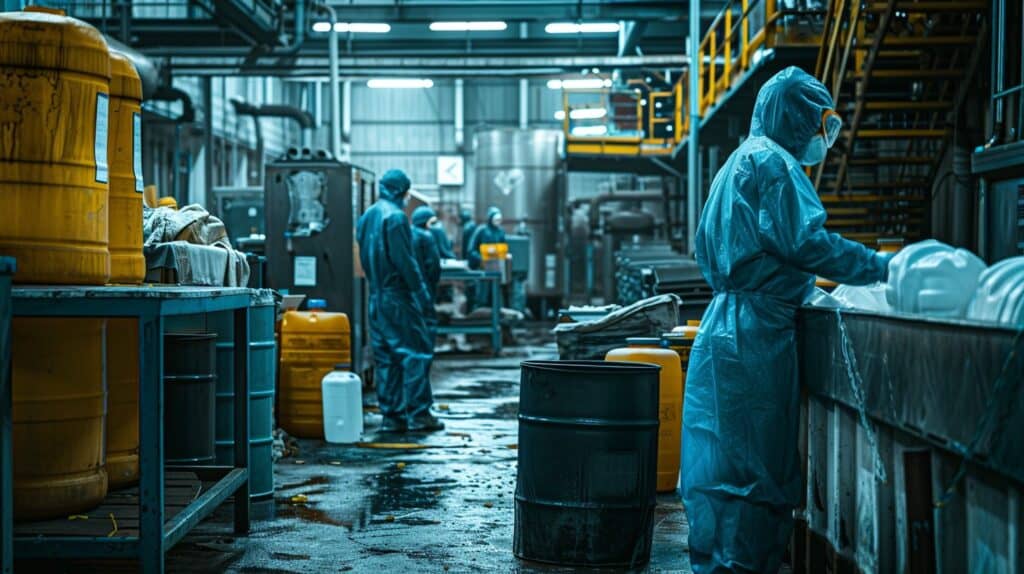
You know, after visiting the doc or getting patched up at the hospital, there’s a lot of stuff—like needles and gloves—that can’t just be tossed in my kitchen trash can. So, where does it all end up? Stick around, and I’ll spill the beans on how that icky medical waste finds its final resting place—sans the scary details, promise!
Drop-off Sites
I’ve got to tell you, drop-off sites are key spots for getting rid of medical waste the right way. Picture this: hospitals and clinics piling up with stuff like used needles or old meds.
Well, they can’t just toss them in the regular trash. Nope, that’s where these special places come in – safe havens for hazardous junk!
Now, some clever folks at Waste Management Inc. teamed up with Moffitt Cancer Center to make these drop-offs even better. They’re not only handling biohazards but also ramping up on recycling – smart move! This means less dangerous garbage sitting around and more stuff getting a second life—win-win for everyone and our planet too!
Treatment, Storage and Disposal Facilities (TSDF)
So, medical waste has to go somewhere safe, and those places are called Treatment, Storage and Disposal Facilities, or TSDF for short. Think of them as the big leagues of trash handling, where they deal with the tough stuff like what comes out of hospitals.
It’s not just any old dumpster — these facilities are specially designed to handle hazardous waste without harming people or the environment.
Now, imagine an elite team that can take care of anything from sharps waste to chemotherapy leftovers. That’s what TSDFs do – they’re equipped with cutting-edge tech to treat, lock up safely or get rid of this risky trash.
Hospitals often work with businesses like Stericycle and Waste Management, Inc., who know all about ferrying dangerous rubbish away safely. Ready for a deep dive into how they make sure infectious medical waste doesn’t cause harm? Let’s talk about autoclaves and other nifty treatment options that zap germs dead in their tracks.
Landfills Or Incinerators
Let’s talk about two big ways we get rid of medical waste – landfills and incinerators. First up, there are special landfills just for healthcare trash. These aren’t your regular garbage dumps; they’re made to safely hold stuff that comes out of hospitals and clinics.
They make sure harmful chemicals don’t leak into the ground or water.
Now, incinerators? They’re like huge ovens that burn up medical waste until it’s ash. This way, it doesn’t take up space in a landfill, and disease-causing germs are killed off by the high heat.
Stanford University Medical Center has been working hard on this front. They’ve cut down what they send to these places while keeping infections away from patients and staff.
Burning this stuff isn’t always perfect though… Sometimes it can let out bad fumes if we’re not careful—yikes! That’s why some smart folks at places like Waste Management, Inc., teamed up with Moffitt Cancer Center to figure out better ways to handle all that biohazardous material without too much harm to our planet.
Cool, right? We all want a cleaner world as much as the next guy!
Medical Waste Recycling Facilities
So, hospitals have this cool way to deal with waste so it doesn’t all end up in landfills. They recycle some of the stuff that’s safe enough to be used again. I’m talking about things like plastics and paper that haven’t been contaminated.
It’s awesome because it means less trash in our environment, right? Stanford University Medical Center is rocking at this; they’ve figured out how to keep infection control top-notch while still sending less to the dump.
Recycling facilities take these clean materials and turn them into new products. Just imagine, the plastic from a hospital could end up as part of your garden chair! Not only does this help cut down on solid waste – which is huge for earth-friendly health tips for men – but also smart recycling keeps things efficient in healthcare facilities too.
Now let’s move on and chat about another important step: treating infectious medical wastes…
Treatment Options for Infectious Medical Waste
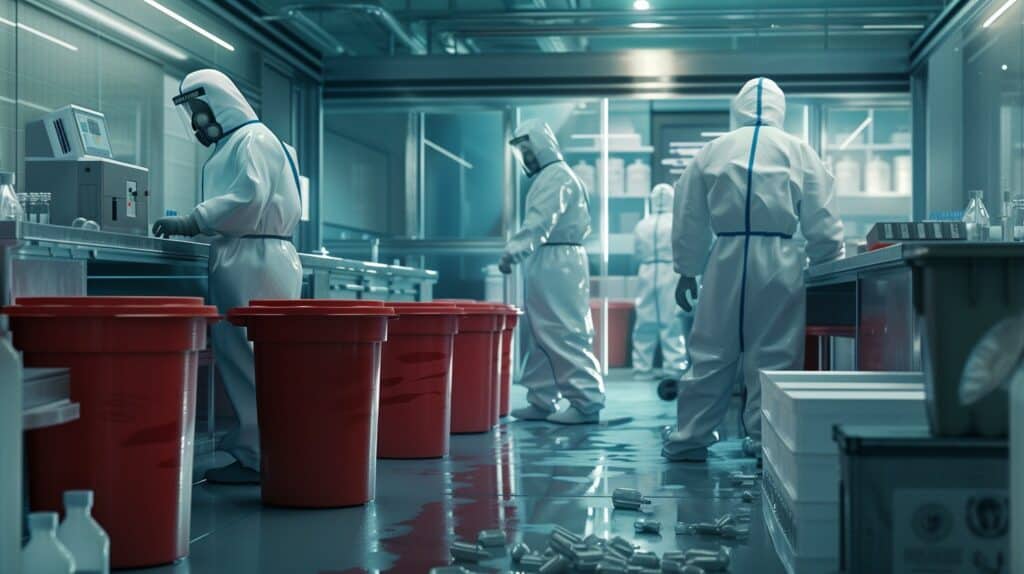
When it comes to the nitty-gritty of getting rid of those nasty bugs hitching a ride on infectious medical waste, we’ve got some pretty sharp (pun intended!) methods up our sleeves—stay tuned to dive into the deets!
Autoclave
So, autoclaves—pretty cool machines. They use steam to kill germs on medical stuff that might make people sick. You know, those instruments doctors use or the gowns they wear? Yeah, all that goes into an autoclave looking dirty and comes out clean as a whistle.
It’s like a superhero for hospital things, zapping away bad bugs with just heat and pressure.
They’re not for everything, though. Some waste can’t handle the heat and needs other ways to get clean or thrown out safely. But when it comes to getting rid of germs on most tools and clothes from hospitals, autoclaving is top-notch.
And hey, making sure we don’t spread diseases around is super important—for me, you, and everyone else trying to stay healthy!
Incineration
Switching gears from autoclaves, I’ve gotta talk about incineration. This method’s like the heavyweight champ of getting rid of hospital waste. Picture this: a massive furnace that burns up medical trash at high temperatures, totally zapping those nasty germs and infectious stuff into thin air.
It’s super effective, but let me tell ya, it’s not everyone’s favorite these days.
I know what you’re thinking—why the cold shoulder for something so powerful? Well, folks are worried about our planet. Burning waste can be rough on the environment and costs a pretty penny too.
That’s why hospitals often mix things up with different disposal methods; they’re trying to find that sweet spot between killing germs and keeping the earth cool. Trust me—it’s all about balance!
Microwave
Now, let’s zap over from burning stuff to microwaving it, like leftovers from last night’s dinner. Picture this – microwave treatment is kind of like that, but for hospital germs and gooey waste that can make people sick.
It’s a popular way to clean up the nasty bits because it uses heat waves to kill off bacteria and viruses without flames or smoke.
Most hospitals actually send their trash out for a good zapping. Let me break it down: they pack up all those infectious gauzes, tubes, and other ickies then ship them off to places with giant microwaves.
There, everything gets cooked until the bad bugs are gone and what’s left is safe enough not to worry about anymore. It’s really smart tech—keeps everyone healthier while cutting down on pollution too!
Hospital Disposal Options for Medical Waste
Ever found yourself wondering, “So, how do hospitals actually get rid of all that gunky stuff?” Well, folks, it’s not like they can just toss it in the dumpster out back. Hospitals have some pretty nifty options to keep things safe and sound—and away from the rest of us.
Stay tuned to uncover the behind-the-scenes action where medical waste waves goodbye…
On-site Treatment
I’m all about keeping things clean and safe, especially when we’re talking about the nasty stuff from hospitals and clinics. So let’s chat about how they deal with medical waste right where it happens – that’s what on-site treatment is all about.
Some places like a big hospital might have their own machines to steam up and kill germs in things like used bandages or gloves. It’s called autoclaving, and it uses super hot steam to make sure everything is sterile before moving on.
Take St. Luke’s Hospital over in Chesterfield, Missouri – they know the drill. After a busy day in the operating room (OR), they toss their red bags filled with waste into an autoclave right there on-site.
Then a service swings by, grabs those bags once everything inside has been zapped of germs, shreds them up so no one can tell what was inside, and gets rid of them for good.
While I’ve got your attention—let me throw this at you: not every bit of trash can go through the high-heat sterilization dance…
Off-site Treatment
So, you’ve got medical waste that needs to go somewhere safe, right? Off-site treatment is your friend here. This means taking all that healthcare rubbish—yep, even the scary infectious stuff—to a place specially made to handle it.
Think of it like sending your garbage on a mini-vacation where experts turn it into something less harmful.
Okay, let’s break it down: these off-site wizards use cool tech like autoclaves (they’re like pressure cookers but for trash) and big ovens called incinerators to zap those germs away.
They even have microwave treatments to nuke the nasty bits out of existence. And because we play by the rules, everything’s sorted by color codes; it makes life easier for everyone. It’s all about keeping things tidy and not mixing up what shouldn’t be mixed.
Heading over to the “Mail Away Service” part next…
Mail Away Service
I get it, sometimes handling medical waste seems like a puzzle with too many pieces. But hey, let’s talk about this mail away service. It’s pretty neat. Picture this: no big machines or special rooms needed at your place, just pack up that biohazard stuff and ship it to the pros who deal with nasty germs every day.
Now, I’ve seen how they do it. You grab a special box – kind of like those kits you see for sending back online shopping returns – but these are made tough for healthcare waste.
Throw in those used gloves, bandages or whatever else that shouldn’t be in regular trash bins. Seal it up tight and send it off! The wizards at the disposal company work their magic so none of us needs to worry about any bad bugs getting out into the world.
Easy-peasy and super safe – just how we like it!
Importance of Healthcare Waste Segregation and Responsibilities
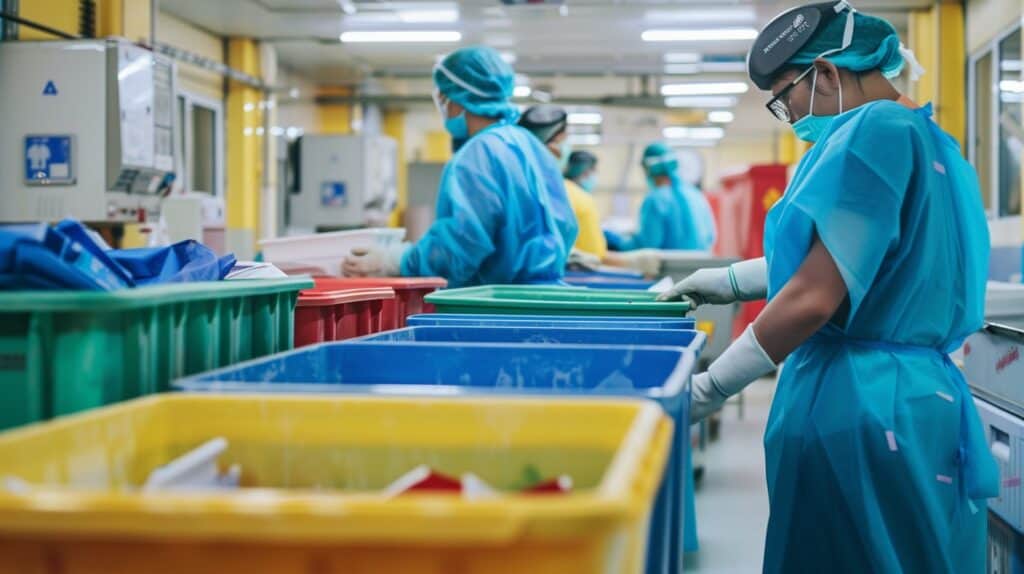
Alright folks, let’s steer towards something crucial yet not so glamorous—segregating those nasty bits of medical waste and whose job it is to deal with them. You see, tossing everything into one big “germ bag” just won’t cut it; getting this part right is a game-changer for everyone’s safety.
So, buckle up as we dive into the world where color-coded bins are superheroes and every healthcare worker plays a vital role in keeping that villainous bacteria from gatecrashing our lives.
Clinical Waste Regulations
So, medical waste has rules it must follow. The law calls this stuff “clinical waste,” and it’s not the kind you can just toss in your trash bin. Nope, I’m talking about things like needles, old meds, and bandages with blood on them—real yucky stuff that could make people sick if they aren’t dealt with the right way.
Now, big words aside (and trust me, there are a lot), there’s something called the Medical Waste Tracking Act of 1988. That’s a mouthful! It lays down the law for getting rid of medical waste safely.
What does this mean? Well, places like hospitals have to keep track of all their nasty garbage from start to finish. They can’t let anything bad sneak into places where folks live or play.
And yeah, agencies like EPA and OSHA are always watching to make sure nobody drops the ball here.
And hey, guys—even us regular Joes need to take note: Ever had to chuck an old bottle of pills? You can’t just throw them away or flush them down the toilet—that’s asking for trouble.
We’ve got drop-off spots for those kinds of things; keeps our water clean and our fish happy too! So let’s play by these rules—it helps everyone stay healthy and keeps our neighborhood safe from harm.
Best Practices for Healthcare Waste Management
I care a lot about keeping things clean and safe, especially at places like hospitals. It’s super important to handle medical waste the right way to stop germs from spreading. Here are some cool moves doctors and nurses use to manage trash safely:
- Use clear bags for stuff that isn’t gross or sharp, like gloves or gowns.
- Put icky things soaked in blood or other fluids in red bags, so everyone knows to be careful.
- Sharp stuff like needles? They go into special boxes called sharps containers. These keep everyone from getting poked!
- Hospitals have a big rulebook, called Clinical Waste Regulations, which tells them how to sort trash and where it should go.
- Some waste can make people sick if they touch it or breathe it in. Workers wear masks and gloves when they deal with this kind of trash.
- Things that touched drugs for serious illnesses get their own bins because they’re extra dangerous.
- Factories outside the hospital can burn waste until it’s not harmful anymore. This process is called incineration.
- Machines called autoclaves use hot steam to clean stuff that has germs on it without setting it on fire.
- People who work at hospitals learn all about these rules so they can do their jobs well and stay healthy.
- Videos and classes teach them the best ways to throw away different kinds of waste.
Medical Waste Has Its Place
So, we’ve taken a little journey through the world of tossing out medical waste. It’s not just thrown away; it goes places like special ovens that burn it up, or gets cleaned and crushed.
Sometimes folks even make new things from old stuff. We all want to stay healthy and keep our planet safe, so handling this kind of trash right is super important. And hey, if hospitals can get creative with recycling too, that’s a win-win for everyone!
FAQs About Medical Waste
What happens to all that stuff from hospitals, like needles and bandages?
Well, there’s this thing called medical waste disposal, right? It’s super important because we don’t want that nasty stuff causing diseases. So they get rid of it safely by either burning it up in special ovens called incinerators or using chemicals and machines to make sure it’s not harmful anymore.
Can any of the medical waste be recycled?
You bet! Not everything goes into the trash. Some medical stuff can be cleaned or melted down—like certain plastics—and turned into new things. It’s kinda cool thinking about a plastic cup becoming part of your park bench!
“Hey doc, what’s this MRSA business I keep hearing about?”
Oh boy, MRSA is a tough germ that doesn’t quit – think of it as the Hulk of superbugs! Hospitals have to be extra careful with their waste, so these germs don’t spread and cause more health problems…and trust me, nobody wants that!
Is tossing out medical waste just like throwing out my old toys?
Nope, not even close! You see, there are some big-time rules (like the Resource Conservation and Recovery Act) for getting rid of yucky hospital garbage safely—to protect people and the planet.
Do doctors know how to throw away all those icky blood tubes and stuff?
For sure—they’ve got scientists in clinics who are like superheroes when it comes to handling hazardous gunk correctly, so everyone stays healthy.
If I’m pregnant or nursing my baby…is all that waste stuff dangerous for us?
Good question! Healthcare folks work really hard at disease control so moms-to-be and little ones stay safe from bad bugs; they use some brainy ways to clean up everything real good!
